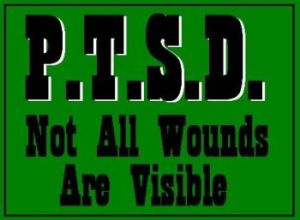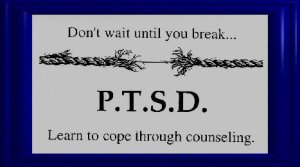~~March 20, 2014~~
What is post-traumatic stress disorder (PTSD)?
Post-traumatic stress disorder (PTSD) can develop following a traumatic event that threatens your safety or makes you feel helpless.
Most people associate PTSD with battle-scarred soldiers — and military combat is the most common cause in men—but any overwhelming life experience can trigger PTSD, especially if the event feels unpredictable and uncontrollable.
Post-traumatic stress disorder (PTSD) can affect those who personally experience the catastrophe, those who witness it, and those who pick up the pieces afterwards, including emergency workers and law enforcement officers. It can even occur in the friends or family members of those who went through the actual trauma.
PTSD develops differently from person to person. While the symptoms of PTSD most commonly develop in the hours or days following the traumatic event, it can sometimes take weeks, months, or even years before they appear.
Traumatic events that can lead to PTSD include:
|
|
| Or any shattering event that leaves you stuck and feeling helpless and hopeless | |
~~The difference between PTSD and a normal response to trauma~~
The traumatic events that lead to post-traumatic stress disorder are usually so overwhelming and frightening that they would upset anyone. Following a traumatic event, almost everyone experiences at least some of the symptoms of PTSD. When your sense of safety and trust are shattered, it’s normal to feel crazy, disconnected, or numb. It’s very common to have bad dreams, feel fearful, and find it difficult to stop thinking about what happened. These are normal reactions to abnormal events.
For most people, however, these symptoms are short-lived. They may last for several days or even weeks, but they gradually lift. But if you have post-traumatic stress disorder (PTSD), the symptoms don’t decrease. You don’t feel a little better each day. In fact, you may start to feel worse.
A normal response to trauma becomes PTSD when you become stuck
After a traumatic experience, the mind and the body are in shock. But as you make sense of what happened and process your emotions, you come out of it. With post-traumatic stress disorder (PTSD), however, you remain in psychological shock. Your memory of what happened and your feelings about it are disconnected. In order to move on, it’s important to face and feel your memories and emotions.
~~Signs and symptoms of post-traumatic stress disorder (PTSD)~~
The symptoms of post-traumatic stress disorder (PTSD) can arise suddenly, gradually, or come and go over time. Sometimes symptoms appear seemingly out of the blue. At other times, they are triggered by something that reminds you of the original traumatic event, such as a noise, an image, certain words, or a smell.
While everyone experiences PTSD differently, there are three main types of symptoms:
- Re-experiencing the traumatic event
- Avoiding reminders of the trauma
- Increased anxiety and emotional arousal
Symptoms of PTSD: Re-experiencing the traumatic event
- Intrusive, upsetting memories of the event
- Flashbacks (acting or feeling like the event is happening again)
- Nightmares (either of the event or of other frightening things)
- Feelings of intense distress when reminded of the trauma
- Intense physical reactions to reminders of the event (e.g. pounding heart, rapid breathing, nausea, muscle tension, sweating)
Symptoms of PTSD: Avoidance and numbing
- Avoiding activities, places, thoughts, or feelings that remind you of the trauma
- Inability to remember important aspects of the trauma
- Loss of interest in activities and life in general
- Feeling detached from others and emotionally numb
- Sense of a limited future (you don’t expect to live a normal life span, get married, have a career)
Symptoms of PTSD: Increased anxiety and emotional arousal
- Difficulty falling or staying asleep
- Irritability or outbursts of anger
- Difficulty concentrating
- Hypervigilance (on constant “red alert”)
- Feeling jumpy and easily startled
Other common symptoms of post-traumatic stress disorder (PTSD)
|
|
~~Symptoms of PTSD in children and adolescents~~
In children — especially those who are very young — the symptoms of PTSD can be different than the symptoms in adults. Symptoms in children include:
- Fear of being separated from parent
- Losing previously-acquired skills (such as toilet training)
- Sleep problems and nightmares without recognizable content
- Somber, compulsive play in which themes or aspects of the trauma are repeated
- New phobias and anxieties that seem unrelated to the trauma (such as a fear of monsters)
- Acting out the trauma through play, stories, or drawings
- Aches and pains with no apparent cause
- Irritability and aggression
~~Post-traumatic stress disorder (PTSD) causes and risk factors~~
While it’s impossible to predict who will develop PTSD in response to trauma, there are certain risk factors that increase your vulnerability.
Many risk factors revolve around the nature of the traumatic event itself. Traumatic events are more likely to cause PTSD when they involve a severe threat to your life or personal safety: the more extreme and prolonged the threat, the greater the risk of developing PTSD in response. Intentional, human-inflicted harm—such as rape, assault, and torture— also tends to be more traumatic than “acts of God” or more impersonal accidents and disasters. The extent to which the traumatic event was unexpected, uncontrollable, and inescapable also plays a role.
Other risk factors for PTSD include:
|
|
~~Full Read/Article/Source~~
http://www.helpguide.org/mental/post_traumatic_stress_disorder_symptoms_treatment.htm
Why Should I Seek Help for PTSD?
- Early treatment is better. Symptoms of PTSD may get worse. Dealing with them now might help stop them from getting worse in the future. Finding out more about what treatments work, where to look for help, and what kind of questions to ask can make it easier to get help and lead to better outcomes.
- PTSD symptoms can change family life. PTSD symptoms can get in the way of your family life. You may find that you pull away from loved ones, are not able to get along with people, or that you are angry or even violent. Getting help for your PTSD can help improve your family life.
- PTSD can be related to other health problems. PTSD symptoms can make physical health problems worse. For example, studies have shown a relationship between PTSD and heart trouble. By getting help for your PTSD you could also improve your physical health.
Source: National Center for PTSD
~~Treatment for post-traumatic stress disorder (PTSD)~~
Treatment for PTSD relieves symptoms by helping you deal with the trauma you’ve experienced. Rather than avoiding the trauma and any reminder of it, treatment will encourage you to recall and process the emotions and sensations you felt during the original event. In addition to offering an outlet for emotions you’ve been bottling up, treatment for PTSD will also help restore your sense of control and reduce the powerful hold the memory of the trauma has on your life.
~~Treatment for PTSD~~
- Explore your thoughts and feelings about the trauma
- Work through feelings of guilt, self-blame, and mistrust
- Learn how to cope with and control intrusive memories
- Address problems PTSD has caused in your life and relationships
Types of treatment for post-traumatic stress disorder (PTSD)
- Trauma-focused cognitive-behavioral therapy. Cognitive-behavioral therapy for PTSD and trauma involves carefully and gradually “exposing” yourself to thoughts, feelings, and situations that remind you of the trauma. Therapy also involves identifying upsetting thoughts about the traumatic event–particularly thoughts that are distorted and irrational—and replacing them with more balanced picture.
- Family therapy. Since PTSD affects both you and those close to you, family therapy can be especially productive. Family therapy can help your loved ones understand what you’re going through. It can also help everyone in the family communicate better and work through relationship problems caused by PTSD symptoms.
- Medication is sometimes prescribed to people with PTSD to relieve secondary symptoms of depression or anxiety. Antidepressants such as Prozac and Zoloft are the medications most commonly used for PTSD. While antidepressants may help you feel less sad, worried, or on edge, they do not treat the causes of PTSD.
- EMDR (Eye Movement Desensitization and Reprocessing) incorporates elements of cognitive-behavioral therapy with eye movements or other forms of rhythmic, left-right stimulation, such as hand taps or sounds. Eye movements and other bilateral forms of stimulation are thought to work by “unfreezing” the brain’s information processing system, which is interrupted in times of extreme stress.
~~What it is like to have PTSD~~
Published on Mar 17, 2013
This is a video about PTSD.
The music is by 3 Doors Down who maintain the rights to the song.

We ALL are ONE!!
~~Excellent Articles~~









Truly, a debilitating condition that can go on for a lifetime when chronic…even with treatments bits and pieces remain but life gets better that way as far as I have been able to see…even many affected Vietnam War veterans still receive support for PTSD today…the earlier the help the better…the earlier the symptoms are recognised the better
LikeLike
TY for your visit and comment. It’s really appreciated. A debilitating disease indeed. Treated many of them when I was working. 🙂
LikeLike
Hm – me too and still do 😀
LikeLike
Then you know .. it can be so hard!!
LikeLike
Yes indeed, for all.
LikeLike
Awesome blog sis! Thank you for posting this.
As you know, I am battling PTSD for quite some time now. It’s good to get this information out there!
Love & Hugz ❤
LikeLike
You’re very welcome. I referenced your articles. Did you see that???
Hugs!! Tight one!!! 🙂
LikeLike
O lol, yes now that you point it out to me I do! 🙂
Thanks! Another big, loving hug coming your way! ❤
LikeLike
Another big one grabbed!! Lil Sis …. luv ya!! 🙂
LikeLike
Reblogged this on "OUR WORLD".
LikeLike
TY for this reblog, Nancy!!! Be well … hugs!! 🙂
LikeLike
Reblogged this on Doctor's Voice/ Medical Corner and commented:
MEDICAL CORNER …. Post traumatic stress disorder! Unseen wounds …
LikeLike